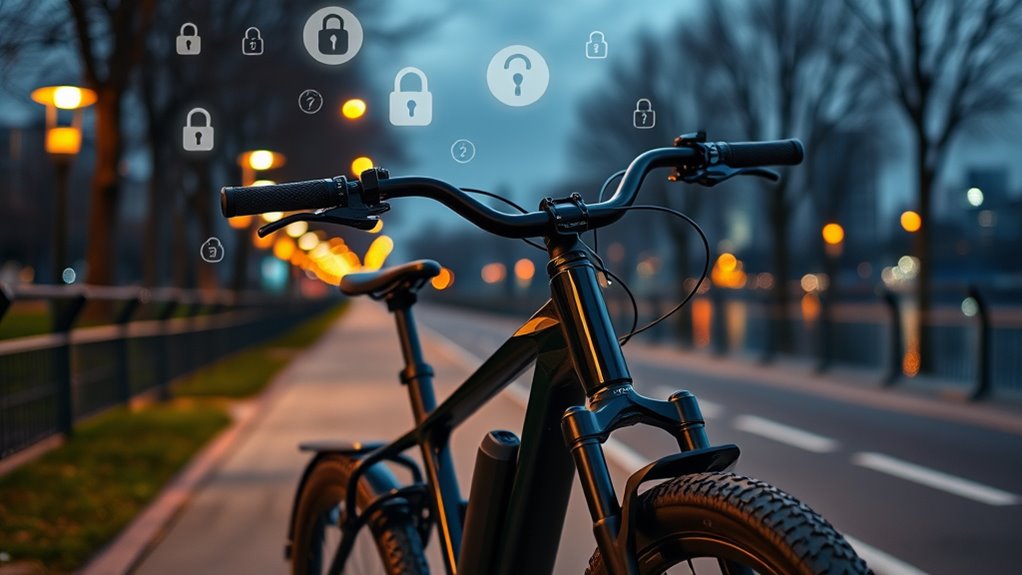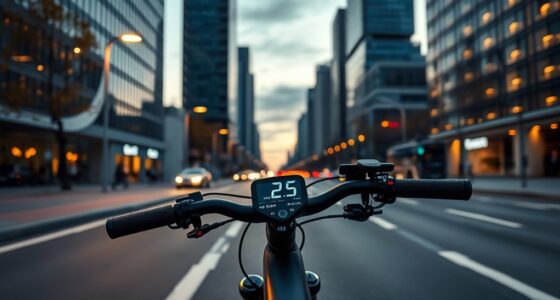Connected e-bike apps collect your location, riding habits, and personal details like weight and fitness level to customize your experience. They track your routes, speed, and ride duration, which can raise privacy concerns if data is shared with third parties or sold. Your personal profiles reveal lifestyle details, and permissions might give apps access to more data than necessary. Managing permissions and understanding privacy policies help protect your privacy—continue to explore to learn how to keep control of your data.
Key Takeaways
- Connected e-bike apps collect GPS location, riding habits, and personal details to customize features and enhance user experience.
- Data collected includes speed, ride duration, preferred routes, and sometimes personal info like weight and fitness level.
- Privacy risks involve potential data sharing with third parties, misuse of sensitive location data, and lack of user awareness.
- Users should review app permissions, privacy policies, and adjust settings to limit data sharing and protect their privacy.
- Best practices include regularly checking permissions, understanding data use, and making informed decisions to balance convenience and privacy.

As connected e-bikes become more popular, they collect a wealth of data about your riding habits, location, and personal preferences. When you hop on your e-bike, it’s not just about getting from point A to B; your bike’s app is constantly gathering information behind the scenes. One major element is GPS tracking, which pinpoints your exact location during every ride. This data helps manufacturers and app developers analyze where and how often you ride, offering insights into your daily routine or favorite routes. While GPS tracking can improve navigation and safety features, it also means your movements are continuously mapped and stored, raising questions about who has access to that information.
In addition to GPS data, your e-bike’s app creates detailed user profiles based on your riding patterns, preferences, and even the times you usually ride. User profiling involves collecting data about your speed, ride duration, preferred routes, and sometimes even your weight and fitness level if you input such information. This helps tailor the app’s features to suit your needs, like suggesting ideal routes or adjusting motor assistance levels. However, it also means your personal riding profile becomes a part of the data ecosystem, potentially shared with third parties for marketing or analytics purposes. If you’re not careful, your riding habits could be used to build a complete picture of your lifestyle.
Understanding how these data collection practices intersect with bedroom design principles can help users better appreciate the importance of privacy and personal space, even in digital environments.
You might think that sharing this data is harmless, especially if it improves your riding experience, but it’s important to remember that these apps often have complex data-sharing agreements. Many collect data not just for your benefit but also to sell or share with advertisers, insurance companies, or third-party analytics firms. This creates privacy risks, especially if sensitive location data falls into the wrong hands. You might not realize how much personal information is being stored or how easily it can be accessed, which makes understanding app permissions essential.
Being aware of what data your connected e-bike app collects is the first step toward protecting your privacy. Check the app’s privacy policy, and be cautious about granting unnecessary permissions. Some apps allow you to opt-out of certain data collection features, so explore those options. Remember, your riding data is valuable — it’s not just about your convenience but also about your privacy rights. Staying informed about GPS tracking and user profiling practices helps you make smarter decisions about how much data you share and with whom. Ultimately, the more you understand, the better you can control your personal information and enjoy your e-bike safely.
Frequently Asked Questions
How Do Apps Share My Data With Third Parties?
Apps share your data with third parties through data sharing agreements, often for marketing, analytics, or service improvement. When you use the app, you may give consent, or the app might automatically grant third-party access via permissions. Always review privacy policies and settings, as third-party access can happen through integrations or data transfers, potentially exposing your riding habits, location, or personal details to outside organizations without you realizing it.
Can I Delete My Data From Connected Bike Apps?
Yes, you can delete your data from connected bike apps. You have user rights to request data removal, and many apps offer settings or support options to do so. Check the app’s privacy settings or contact customer support to manage data retention and request removal. Remember, deleting your data helps protect your privacy and ensures your personal information isn’t stored longer than necessary.
Are There Risks if My Bike Is Hacked?
Yes, if your bike gets hacked, it can pose serious risks. Cybersecurity vulnerabilities might allow hackers to access your personal data or even control your bike remotely, putting your safety at risk. You should be aware of user privacy concerns, as a breach could expose sensitive information or compromise your security. To protect yourself, keep your app and firmware updated, use strong passwords, and stay informed about potential cybersecurity threats.
What Permissions Do E-Bike Apps Typically Request?
Imagine your e-bike app as a helpful guide, asking for permissions like access to your location to show nearby trails, control over battery life to optimize rides, and customization options to personalize your experience. It might request access to your camera or contacts for app features, but be cautious. These permissions help enhance your ride, but always review what data you’re sharing to keep your privacy secure.
How Is My Location Data Protected During Rides?
During your rides, your location data is protected through GPS tracking with encryption, ensuring your position stays secure. You can also manage privacy settings in your app to limit data sharing or disable GPS tracking altogether. It’s important to review these settings regularly, so you stay in control of your privacy. Always keep your app updated, as developers improve security measures to better safeguard your location data during every ride.
Conclusion
As you ride your connected e-bike, remember that knowledge is power—especially when it comes to your data privacy. Stay informed about what apps collect and how they use your information, because a cautious rider is a safer rider. Don’t let your personal data pedal away without your awareness. As the saying goes, “Forewarned is forearmed,” so take control of your digital footprint and enjoy your ride securely and confidently.









